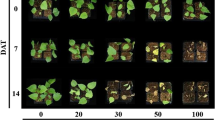Abstract
With an increase in the contamination of urban areas, more and more attention has been paid to the role of ornamental plants in remedying contaminated soils. Thus, cadmium (Cd) tolerance and accumulation characteristics of Calendula officinalis and Althaea rosea as ornamental plants under the concentration gradient experiment with single Cd, as well as the effect of ethylenegluatarotriacetic acid (EGTA) and sodium dodecyl sulfate (SDS) on their Cd phytoremediation capacity under the chemically enhanced experiment was further investigated. It was showed that they had strong tolerance and accumulation capacity of Cd under single Cd treatments, thus they had great potential to be used for Cd contaminated soil remediation. Furthermore, under chemically enhanced treatments, the great efficiency was found through applying EGTA and SDS, they could not only increase the dry biomass of the plants, but also promote the Cd accumulation in shoots and roots. Particularly, Althaea rosea can be regarded as a potential Cd-hyperaccumulator through applying chemical agents. In conclusion, the two ornamental plants are promising to be used for phytoremediation.




Similar content being viewed by others
References
Bañuelos GS, Ajwa HA, Mackey LL, Wu C, Cook S, Akohoue S (1997) Evaluation of different plant species used for phytoremediation of high soil selenium. J Environ Qual 26:639–646
Blaylock MJ, Salt DE, Dushenkov S, Zakharova O, Gussman C, Kapulnik Y, Ensley BD, Raskin I (1997) Enhanced accumulation of Pb in Indian mustard by soil-applied chelating agents. Environ Sci Technol 31:860–865
Huang JW, Chen J, Berti WR, Cunningham DS (1997) Phyto-remediation of lead-contaminated soils: role of synthetic chelates in lead phytoextraction. Environ Sci Technol 31:800–805
Liu JN, Zhou QX, Wang XF, Zhang QR, Sun T (2006) Potential of ornamental plant resources applied to contaminated soil remediation. In: Teixeira da Silva JA (ed) Floriculture, ornamental and plant biotechnology: advances and topical issues, vol 3. Global Science Books, London, UK, pp 245–252
Ma YL (2003) The role of domestic floriculture in prevention and treatment of pollution (in Chinese). J Changchun Univ 13:21–29
Meers E, Lamsal S, Vervaeke P, Hopgood M, Lust N, Tack FMG (2005) Availability of heavy metals for uptake by Salix viminalis on a moderately contaminated dredged sediment disposal site. Environ Pollut 137:354–364
Salt DE, Smith RD, Raskin I (1998) Phytoremediation. Annu Rev Plant Physiol 49:643–648
Satos FS, Hernández-Allica J, Becerril JM, Amaral-Sobrinho N, Mazur N, Garbisu C (2006) Chelate-induced phytoremediation of metal polluted soils with Brachiaria decumbens. Chemosphere 65:43–50
Vangronsveld J, van Assche F, Clijsters H (1995) Reclamation of a bare industrial area contaminated by non-ferrous metals: in situ metal immobilization and revegetation. Environ Pollut 87:51–59
Wang X, Zhou QX (2003) Distribution of forms for cadmium, lead, copper and zinc in soil and its influences by modifier (in Chinese). J Agro-Environ Sci 22:541–545
Wang XF (2005) Resource potential analysis of ornamentals applied in contaminated soil remediation (in Chinese). A dissertation in Graduate School of Chinese Academy of Sciences, Beijing, China
Wei SH, Zhou QX (2004) Identification of weed species with hyperaccumulative characteristics of heavy metals. Prog Nat Sci 14:495–503
Xia JQ (1996) Detail explanation on the state soil-environment quality standard of China (in Chinese). Chinese Environmental Science Press, Beijing, China
Zhou QX, Song YF (2001) Technological implications of phytoremediation and its application in environmental protection (in Chinese). J Safe Environ 1:48–53
Zhou QX, Song YF (2004) Principles and methods of contaminated soil remediation (in Chinese). Science Press, Beijing
Zhou QX, Wei SH (2006) Research on agricultural environment and its international trends (in Chinese). Crops 2:1–3
Zhou QX, Wei SH, Diao CY (2007) Basic principles and researching progresses in ecological remediation of contaminated soils. J Agro-Environ Sci 26:419–424
Acknowledgments
The work was supported by the Ministry of Science and Technology, People’s Republic of China as a 863 Project (No. 2006AA06Z386) and by the National Natural Science Foundation of China for distinguished overseas young Chinese scholars (No. 20428707).
Author information
Authors and Affiliations
Corresponding author
Rights and permissions
About this article
Cite this article
Liu, JN., Zhou, QX., Sun, T. et al. Identification and Chemical Enhancement of Two Ornamental Plants for Phytoremediation. Bull Environ Contam Toxicol 80, 260–265 (2008). https://doi.org/10.1007/s00128-008-9357-1
Received:
Accepted:
Published:
Issue Date:
DOI: https://doi.org/10.1007/s00128-008-9357-1




